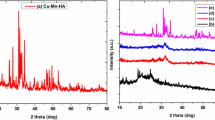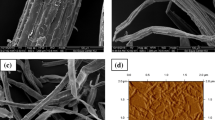Abstract
Hydrogels are three-dimensional polymeric networks with segments of hydrophilic groups. Stimuli-responsive hydrogels have played attractive role toward much research due to slight modification of environment by abrupt changes in swelling behavior. In this study, a series of pH-sensitive biocomposite hydrogels were acquired through solvent-free green approach by utilization of diethylene glycol (DEG), citric acid (CA), acrylic acid (AA) and hydroxyapatite (HA). Incorporation of hydroxyapatite (HA) prepared from waste eggshells with ACD resulted in the biocomposite hydrogel (ACD–HA). The synthesized biocomposite hydrogel was examined by various characterization techniques, viz., spectral (FTIR), powder X-ray diffraction (XRD) technique, thermal (TGA and DTG), morphological (SEM) and swelling equilibrium studies. In addition, HA was surface treated with two different silane-based coupling agents, namely 3-aminopropyltrimethoxysilane (AMS) and vinyltriethoxysilane (VES) on the performance properties of biocomposite hydrogels. The results of the studies revealed that VES-treated ACD–HA had superior properties than AMS-treated ACD–HA and untreated ACD–HA on overall properties of biocomposite hydrogels. Hence, the decreasing order of swelling equilibrium behavior in various pH, viz., 4.0, 6.0, 7.4, 8.0, 10.0, has been listed as ACD–HA–VES > ACD–HA–AMS > ACD–HA > ACD. The observations indicated that hydrogels’ adaptability with pH-tuned properties may have greater potential in eco-friendly approaches such as metal ion removal, dye removal and agrochemical release.








Similar content being viewed by others
References
Parikh SN (2002) Bone graft substitutes in modern orthopaedics. Orthopedics 25:1301–1309
Rosen HM, McFarland MM (1990) The biologic behavior of hydroxyapatite implanted into the maxillofacial skeleton. Plast Reconstr Surg 85:718–723
Hes J, Deman K (1990) Use of blocks of hydroxylapatite for secondary reconstruction of the orbital floor. Int J Oral Max Surg 19:275–278
Bajpai AK, Bundela H (2010) γ-radiation assisted fabrication of hydroxyapatite-polyacrylamide nanocomposites with possible application in bone implantology. J Compos Mater 44:757–778
Moharram MA, Khafagi MG (2007) Application of FTIR spectroscopy for structural characterization of ternary poly(acrylic acid)-metal-poly(vinyl pyrrolidone) complexes. J Appl Polym Sci 105:1888–1893
Tran N, Hall D, Webster TJ (2012) Mechanisms of enhanced osteoblast gene expression in the presence of hydroxyapatite coated iron oxide magnetic nanoparticles. Nanotechnology 23:455104
Larena A, Caceres DA, Vicario C, Fuentes A (2004) Release of a chitosan–hydroxyapatite composite loaded with ibuprofen and acetyl-salicylic acid submitted to different sterilization treatments. Appl Surf Sci 238:518–522
Ray SS, Okamoto M (2003) Polymer/layered silicate nanocomposites: a review from preparation to processing. Prog Polym Sci 28:1539–1641
Dupoirieux L (1999) Ostrich eggshell as a bone substitute: a preliminary report of its biological behaviour in animals—a possibility in facial reconstructive surgery. Br J Oral Maxillofac Surg 37:467–471
Ozyegin S, Oktar FN, Golle G, Kayal ES, Yazici T (2004) Plasma-sprayed bovine hydroxyapatite coatings. Mater Lett 58:2605–2609
Rivera EM, Araiza M, Brostow W, Castano VM, Diaz-Estrada JR, Hernandez R, Rodríguez JR (1999) Synthesis of hydroxyapatite from eggshells. Mater Lett 41:128–134
Peppas NA, Mikos AG (1986) Hydrogels in Medicine and Pharmacy. In: Peppas NA (ed), vol 1. CRC Press, Florida
Yang J, Motlagh D, Allen JB, Webb AR, Kibbe MR, Aalami O, Kapadia M, Carroll TJ, Ameer GA (2006) Modulating expanded polytetrafluoroethylene vascular graft host response via citric acid-based biodegradable elastomers. Adv Mater 18:1493–1498
Dobic SN, Filipovic JM, Tomic SL (2012) Synthesis and characterization of poly(2-hydroxyethyl methacrylate/itaconic acid/poly(ethylene glycol) dimethacrylate) hydrogels. Chem Eng J 179:372–380
Chiu HC, Hus YH, Lin PJ (2002) Synthesis of pH-sensitive inulin hydrogels and characterization of their swelling properties. J Biomed Mater Res 61:146–152
Amany IR, Aisha ASE, Aida AS, Nashwa SA (2013) Characterization and bioactivity evaluation of (starch/N-vinylpyrrolidone)—hydroxyapatite nanocomposite hydrogels for bone tissue regeneration. J Appl Polym Sci 128:1697–1705
Nikpour MR, Rabiee SM, Jahanshahi M (2012) Synthesis and characterization of hydroxyapatite/chitosan nanocomposite materials for medical engineering applications. Compos B 43:1881–1886
Guhanathan S, Saroja Devi M, Murugesan V (2001) Effect of coupling agents on the mechanical properties of fly ash/polyester particulate composites. J Appl Polym Sci 82:1755–1760
Langroudi AE, Yousefi AA, Kabiri K (2002) Effect of silane coupling agent on interfacial adhesion of copper/glass fabric/epoxy composites. Iran Polym J 12:201–210
Franklin DS, Guhanathan S (2014) Synthesis and characterization of citric acid-based pH-sensitive biopolymeric hydrogels. Polym Bull 71:93–110
Bundela H, Bajpai AK (2008) Designing of hydroxyapatite-gelatin based porous matrix as a bone substitute: Correlation with biocompatibility aspects. Express Polym Lett 2:201–213
Mahmoodi M, Hashemi PM, Imani R (2014) Characterization of a novel nanobiomaterial fabricated from HA, TiO2 and Al2O3 powders: an in vitro study. Prog Biomater 3:25
Jagur-Grodzinski J (2010) Polymeric gels and hydrogels for biomedical and pharmaceutical applications. Polym Adv Technol 21:27–47
Tuncer C, Cengiz O, Omer K, Olgun G (2000) Equilibrium swelling behavior of pH- and temperature sensitive poly(N-vinyl 2-pyrrolidone-g-citric acid) polyelectrolyte hydrogels. J Polym Sci Polym Phys 38:2063–2071
Nho YC, Lim YM, Lee YM (2004) Preparation, properties and biological application of pH-sensitive poly(ethylene oxide) (PEO) hydrogels grafted with acrylic acid (AAc) using gamma-ray irradiation. Radiat Phys Chem 71:239–242
Saber-Samandari S, Saber-Samandari S, Gazi M, Cebeci FC, Talasaz E (2013) Synthesis, characterization and application of cellulose based nano-biocomposite hydrogels. J Macromol Sci Pure Appl Chem Part A 50:1131–1134
Lin OH, Akil HM, Mohd Ishak ZA (2011) Surface-activated nanosilica treated with silane coupling agents/polypropylene composites: mechanical, morphological, and thermal studies. Polym Compos 32:1568–1583
Perruchot C, Chehimi MM, Mordenti D, Brianda M, Michel D (1998) The role of a silane coupling agent in the synthesis of hybrid polypyrrole–silica gel conducting particles. J Mater Chem 8:2185–2193
Acknowledgments
One of the authors, Mr. D.S. Franklin, gratefully acknowledges the authorities of C. Abdul Hakeem College of Engineering and Technology, Melvisharam, Tamilnadu, India for providing laboratory facilities. The authors also wish to thank STIC, Cochin University of Science and Technology, Kerala, India, for their assistance with instrumentation facilities.
Author information
Authors and Affiliations
Corresponding author
Rights and permissions
About this article
Cite this article
Franklin, D.S., Guhanathan, S. Performance of silane-coupling agent-treated hydroxyapatite/diethylene glycol-based pH-sensitive biocomposite hydrogels. Iran Polym J 23, 809–817 (2014). https://doi.org/10.1007/s13726-014-0278-z
Received:
Accepted:
Published:
Issue Date:
DOI: https://doi.org/10.1007/s13726-014-0278-z




